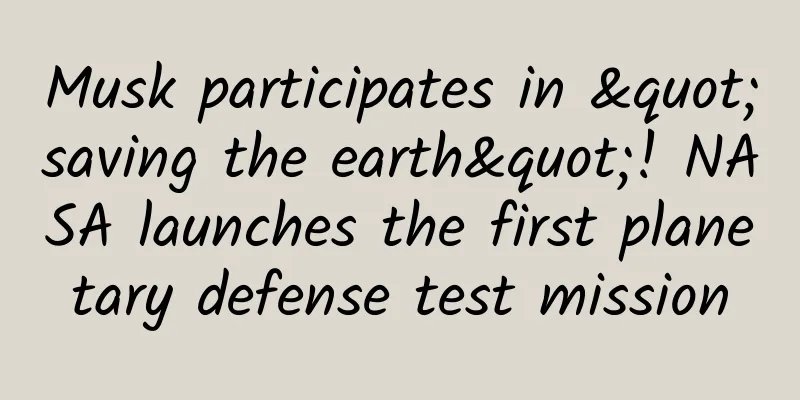Musk participates in "saving the earth"! NASA launches the first planetary defense test mission

|
66 million years ago, an asteroid about 10 kilometers in diameter hurtled through the atmosphere, leaving a giant scar on the coast of Mexico’s Yucatán Peninsula. The impact caused global tsunamis and fires, and wiped out the dinosaurs. Planetary collisions have always been one of the most concerning issues for astronomers and a favorite subject for Hollywood blockbusters. In "Armageddon," tough guy Bruce Willis led his deep-sea oil drilling team to dig holes and bury explosive packs on meteorites, and eventually sacrificed his life to protect the Earth. Today, NASA has brought the movie plot of saving the Earth into real life. At 1:21 a.m. local time on November 23 (14:21 p.m. Beijing time on November 24), the SpaceX Falcon 9 rocket was successfully launched from the Vandenberg Space Force Base in California and carried out a "planetary defense" exercise mission. The exercise, called the Double Asteroid Redirection Test (DART), is expected to cost $330 million. The exercise was a collaboration between the Johns Hopkins Applied Physics Laboratory (APL), the Jet Propulsion Laboratory (JPL), the Goddard Space Flight Center (GSFC), the Johnson Space Center (JSC), the Glenn Research Center (GRC), and the Langley Research Center (LARC). NASA said the target asteroid Dimorphos poses no threat to the Earth. But its operating system is a near-perfect test site for testing whether impacting an asteroid can effectively change its orbit. Although no asteroid larger than 140 meters in diameter will hit the Earth in the next 100 years, only about 40% of asteroids have been discovered by humans as of October 2021. That is to say, there are still many more unknown asteroids orbiting in space, and whether they will come into close contact with the Earth is also an unknown. DART mission diagram | Image source: NASA After launch, DART will deploy the Roll Out Solar Array (ROSA) to provide the solar energy needed for the electric propulsion system. It will also activate the NASA-developed Evolutionary Xenon Thruster – Commercial (NEXT-C) solar electric propulsion system to test the next generation of ion engine technology. After about 10 months of flight, the robotic probe on board the rocket will "die heroically" in late 2022 and crash into the Dimorphos asteroid. In the first 10 days of the Earth Defense War, the robotic probe will launch a CubeSat, a small satellite built by the Italian Space Agency, to record the entire exercise. Four hours before impact, the probe will enter fully autonomous mode, using an onboard camera called Draco and sophisticated autonomous navigation software to hurtle toward the target at 6.6 kilometers per second, 10 times faster than a fighter jet and enough force to create a crater 10 to 20 meters in diameter on Dimorphos. NASA predicts that the collision will change Dimorphos's speed by one percent and cause its orbital period to deviate by a few minutes, a change that is only a few minutes, but can be observed and measured by scientists on Earth with advanced telescopes. DART diagram | Image source: NASA In addition to the impact method used in this DART exercise, scientists have proposed many other methods to eliminate the threat of asteroids, such as vaporizing them with lasers, using the gravity of spacecraft to change their course, and even more ruthless methods are to blow them up with explosives. On October 31, Philip Lubin and Alexander Cohen submitted a 131-page paper to the journal Advances in Space Research, called Project Pi for Planetary Attack. The main idea of the π plan is to set cylindrical metal rods with a diameter of 10-30 cm and filled with explosives in the orbit of asteroids. When asteroids hit them at a very fast speed, they will be blown into a large number of fragments with a diameter of about 10 meters or less. The energy generated by the explosion will be converted into heat, sound and light. At that time, the atmosphere will evaporate the fragments like a bulletproof vest, reducing the impact. Philip Lubin estimates that the sonic shock waves and the related light and heat generated by the explosion will still cause some damage to the ground, but it will be minimal. The most important thing is that compared with the "planetary defense" plan, the π plan has more advantages in responding to emergencies: "The problem with deflecting asteroids is that the response time it requires is very limited. In other words, you need to deflect the orbit of the asteroid long before it approaches the earth." In contrast, the time required for the π plan is much shorter. According to the author's calculations, an asteroid with a diameter less than 50 meters can be successfully intercepted 5 hours before impact. An asteroid with a diameter less than 100 meters can be intercepted one day before impact. An asteroid with a diameter less than 370 meters can be intercepted 10 days before impact. And an asteroid with a diameter less than 20 meters can be intercepted 100 seconds before impact.
Over the past 100 years, the Earth has been hit by several asteroids, but fortunately none of them caused major casualties. The most recent meteorite fall occurred in our neighboring country, Russia. On February 15, 2013, an asteroid with a diameter of about 19 meters broke through the atmosphere over Chelyabinsk, Russia, at a shallow angle of 20° and a speed of about 65,000 km/h (53 times the speed of sound). After burning violently for about 30 seconds, it finally disintegrated and exploded at an altitude of 20-25 kilometers above the ground. The huge energy was transmitted to the ground, causing damage to more than 7,000 buildings in a radius of thousands of square kilometers, and as a result, more than 1,500-2,000 people were injured. chelyabinsk event | Image source: The New York Times Astronomers predict that on April 13, 2029, an asteroid named Apophis with a diameter of 370 meters will pass by the Earth. It will come into close contact with the Earth again in 2036, 2051 and 2066. Although the Earth will not be in any danger in 2029, Apophis's repeated visits still make many astronomers sweat. Philip Lubin even compared it to a bullet whizzing overhead. The difference is that the impact energy carried by this "bullet" is equivalent to the sum of all the nuclear arsenals in the world. What's more, astronomers believe that asteroids like Apophis pose a "gravitational keyhole" threat. This means that during their close flybys, they may pass through a specific region of near-Earth space, where the Earth's gravity will adjust their trajectory, leading to a future impact with the Earth. Therefore, whether it is the defense method of the DART exercise or the attack method of the π plan, it is always a good thing to be fully prepared for the threat posed by asteroids as early as possible. After all, the earth is the common home of mankind and all living things. References: Written by: Liu Fang Editor: HS Layout: Li Xuewei Source: Academic Headlines |
>>: Why do I always feel my heart pounding?
Recommend
2022 National Regulations on Rent Reductions Due to the Epidemic: Some businesses in medium and high-risk areas will be exempted from half a year’s rent!
Recently, affected by the epidemic, merchants in s...
Office workers who make coffee or tea, you may have chosen the wrong time to wash the cups!
In our daily lives, there are many small habits t...
How much does it cost to attract investors for Fuzhou’s bargaining app? What is the investment price of Fuzhou Bargaining Mini Program?
How much does it cost to invest in the bargaining...
The Mystery of Gigantopithecus and Humans in Lingnan's Prehistoric History
Lingnan entered the Cenozoic Paleocene, and life ...
Why is the image quality on Android not as high as on iOS?
I often see people asking: "Why are the pict...
Severe convective weather is "temperamental", and the "killer weapon" to subdue it: short-term nowcast
□ Science Times reporter Hu Lijuan Recently, Beij...
How did modern humans “climb onto” the Qinghai-Tibet Plateau? A gift from the Denisovans
Produced by: Science Popularization China Author:...
Be careful! The power sockets in high-speed trains are really harmful to your phone
The annual Spring Festival travel rush has offici...
How to do a good job in marketing and promotion of enterprise apps
With the popularity of smart phones and the rise ...
"Dear, Princess Syndrome" has been viewed over 500 million times. Zhang Chaoyang: Online dramas will revolutionize the way Chinese people entertain themselves
When it comes to domestic idol dramas, the "...
Facebook and Twitter's "Growth Hackers" tell you about user growth!
Andy Jones was a growth hacker for companies such...
Google development team recruits Node.js transplant engineers Fuchsia is expected to support JavaScript applications
Google's Fuchsia operating system, which has ...
The efficacy and function of honey and Ganoderma lucidum wine, the function and consumption method of honey and Ganoderma lucidum
In many people's minds, Ganoderma lucidum act...
What are the advantages and features of WeChat mini programs? How to obtain traffic?
Q: What are the advantages of mini programs in ac...
He led a national research institute at the age of 32, moved to China in his prime, and discovered the "Yangshao Culture"
Andersson was a famous Swedish geologist, paleont...









